Do you want to know how to massage your back to get maximum relaxation and relief? Massage therapy has been used for centuries to reduce stress and tension, improve circulation and reduce pain. Massaging your back can help you relax and release tight muscles, providing deep relaxation and relief. This article will provide step-by-step instructions on how to massage your back for maximum relaxation and relief.
Contents
Types of Back Massages
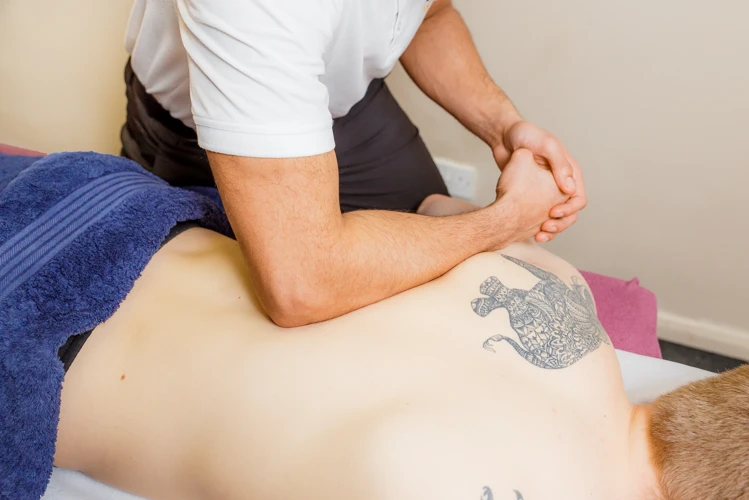
Massaging While Sitting Up
How to give a back massage sitting up? Sitting up is the most common type of back massage and is often the preferred method for those who feel uncomfortable lying down. To perform this type of massage, start by sitting behind the person and use your hands to knead and stroke the muscles on the back. Continue this motion until the person is relaxed and their muscles are warmed up.
Massaging a Person’s Back
To massage a person’s back, use both hands to gently knead and rub the muscles in the back. Start by using your palms to lightly stroke the area before gradually applying more pressure. Focus on the areas that feel tight and use circular motions to help relax the muscles. As the person becomes more relaxed, use your fingertips to apply pressure to the area and target specific knots.
Preparing for the Massage
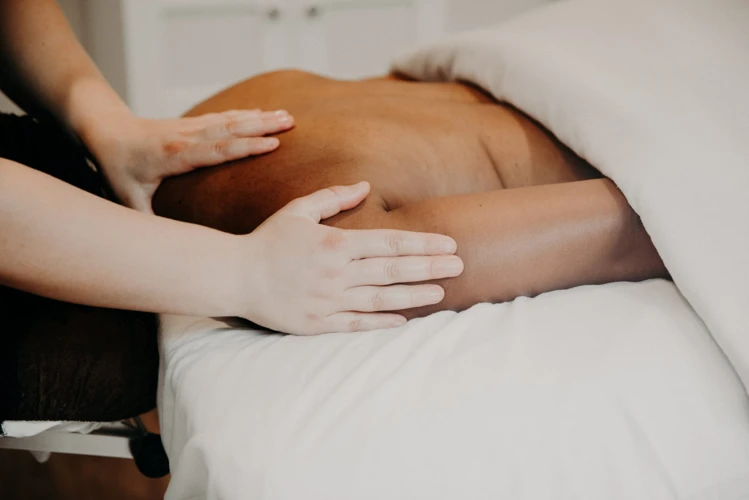
Before you start massaging your back, it is important to take the time to prepare. This involves making sure you have the right equipment and setting up an environment that is conducive to relaxation.
Equipment
| Equipment | Description |
|---|---|
| Massage oil | Use a light massage oil to help the hands glide smoothly over your skin. |
| Towel | Have a clean, dry towel available to cover yourself or the area you are massaging. |
| Pillow | A pillow can help support your neck and head when you are lying down. |
Environment
- Create a comfortable and quiet environment in which to relax.
- Turn off any electronic devices that may be distracting.
- Put on some calming music if desired.
- Light a candle or two to set the mood.
Once you have your equipment and environment set up, you are ready to begin your massage. Remember to take your time and use gentle, slow strokes when massaging your back. This will help you relax and get the most out of your massage.
Massage Techniques
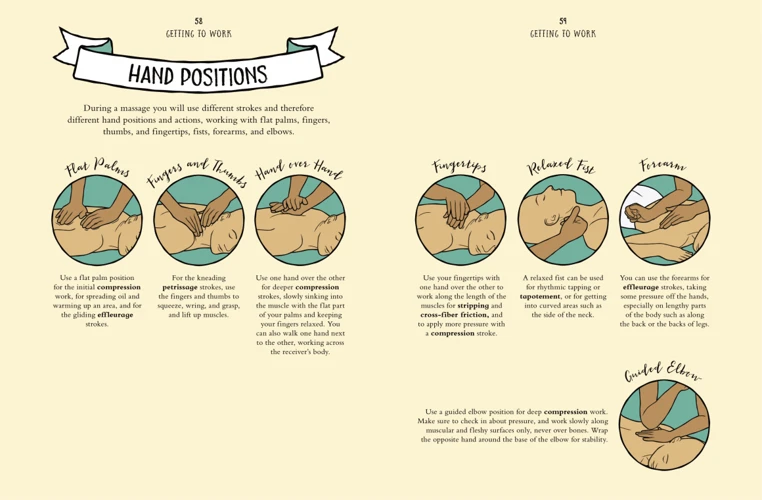
Compressions
Compressions are a great way to begin your massage. Start by rubbing your hands together to create warmth and then slowly press your hands into the muscles of your back. Move your hands in a circular motion and apply pressure in a firm but gentle manner. Focus on any areas that feel particularly tense and release them using your hands.
Effleurage
Effleurage is a gentle circular massage technique that helps to relax your muscles and increase circulation. Begin by placing your hands flat against your back and then use your fingers to stroke over your skin in a smooth and gentle manner. Move slowly and apply a light pressure while covering the entire area of your back.
Petrissage
Petrissage is a kneading massage technique that helps to increase circulation and relieve tension. Start by using your fingers and thumbs to firmly press into the muscles of your back. Move your hands in a circular motion and use a moderate pressure. Focus on any areas that feel particularly tight and use your kneading motions to release the tension.
Friction
Friction is a deep tissue massage technique that helps to relieve muscle tension and improve blood flow. Use your fingers to make small circular motions and apply pressure with your fingertips. Focus on any areas that feel particularly tight and use your fingertips to massage them.
No matter how you choose to massage your back, it is important to make sure you are using the right technique and pressure. By following these steps and focusing on any areas that feel particularly tense, you will be able to effectively massage your back and experience maximum relaxation and relief. So, if you’re wondering how do you massage a back for maximum relaxation and relief, try out these massage techniques.
Targeted Areas
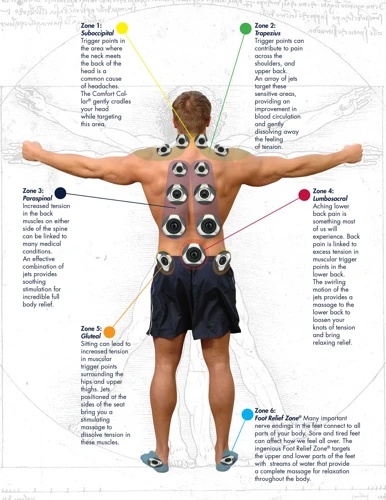
| Area | Technique |
|---|---|
| Upper Back | Use your thumbs to press and massage in a circular motion |
| Middle Back | Use your palms to press and work in a circular motion |
| Lower Back | Use your knuckles to press and massage in a circular motion |
| Shoulders | Use your fingers to press and massage in a circular motion |
| Neck | Use your fingertips to press and massage in a circular motion |
For maximum relaxation and relief, focus on the targeted areas of the back, shoulders and neck. Using a circular motion and varying amounts of pressure, massage each area for several minutes.
Massage Intensity
- Start slow: Begin the massage with gentle, slow strokes. This will help to relax the muscles and create a sense of comfort.
- Gradually increase intensity: Increase the pressure and intensity of the massage as the muscles become more relaxed. Go slowly so as to not cause discomfort.
- Listen to your body: Pay close attention to the level of intensity and adjust accordingly. If the massage feels too intense, lighten the pressure.
- Focus on problem areas: Increase the intensity in areas that are especially tense or tight. Spend more time on these areas to help release the tension.
Benefits
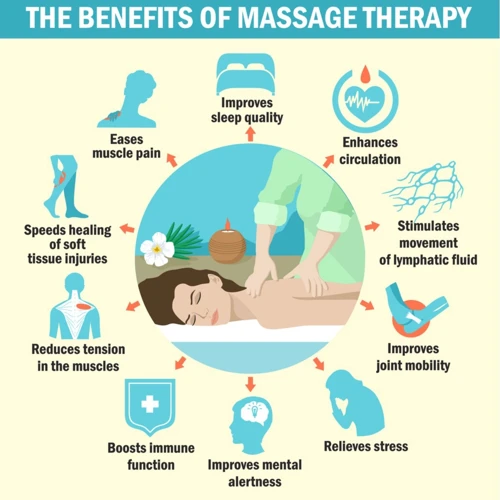
- Reduces Stress: Massage helps to reduce stress and anxiety, allowing your body to relax and loosen up, providing relief from fatigue and tension.
- Improves Circulation: Massage helps to improve circulation throughout the body, increasing the flow of oxygen and nutrients to the muscles.
- Relieves Pain: Massage helps to relieve pain from muscle tension and joint stiffness, providing relief from chronic pain.
- Boosts Immunity: Massage helps to boost the immune system, increasing resistance to infection and illness.
- Enhances Mobility: Massage helps to increase flexibility and range of motion, improving mobility and allowing for easier movement.
- Improves Posture: Massage helps to improve posture by loosening tight muscles, increasing strength and improving balance.
Aftercare
Relax: After the massage, allow yourself to relax for at least 10 minutes. This will help your body to absorb the benefits of the massage and allow it to relax further.
Drink water: After a massage, it is important to drink plenty of water. This will help to flush out toxins that were released during the massage.
Avoid strenuous activity: After a massage, it is best to avoid any strenuous activity for at least 12 hours. This will help to ensure that your body has time to rest and recover from the massage.
Use heat: After a massage, it is beneficial to use heat to further relax your muscles. This can be done with a heating pad or a warm bath.
Avoid alcohol: Alcohol can interfere with the benefits of the massage, so it is best to avoid alcohol for at least 24 hours after the massage.
| Activity | Timeframe |
|---|---|
| Relax | 10 minutes |
| Drink Water | As needed |
| Avoid strenuous activity | 12 hours |
| Use heat | As needed |
| Avoid alcohol | 24 hours |
Frequently Asked Questions
What Kind of Massage is Best for Back Pain Relief?
Deep tissue massage is the most effective type of massage for back pain relief. This type of massage targets the deeper muscles of the back and helps to release tension and stiffness. It can also help to improve blood circulation and reduce inflammation. Additionally, Swedish massage is also recommended for relieving back pain as it helps to reduce tightness and improve mobility.
How Often Should I Massage My Back?
For maximum relaxation and relief, massage your back regularly, at least once a week. If you experience chronic pain, you may need to massage your back more frequently. Consult your doctor or physical therapist to determine the frequency that’s best for you, as well as the techniques that are best suited to your individual needs.
What Type of Oil Should I Use for a Back Massage?
The best type of oil to use for a back massage is a light, hypoallergenic oil such as grapeseed, sunflower, almond, or jojoba oil. Using a light oil ensures that the massage will glide smoothly across the skin without leaving a greasy or sticky residue. It also helps to nourish and hydrate the skin. For a more relaxing experience, you can also add essential oils such as lavender or chamomile to the massage oil for a pleasant aroma.
Is it Safe to Massage My Own Back?
Yes, it is safe to massage your own back with the right techniques. Self-massage can help alleviate soreness, reduce tension, and improve circulation. Before beginning a massage, however, it’s important to be aware of potential risks and take steps to ensure your own safety.
- Warm up: Stretch out your back muscles before massaging them. Gentle stretching helps to prepare your body for the massage, and can help reduce the risk of muscle strain.
- Use a lubricant: Oils or lotions can reduce friction and help you move your hands smoothly over your skin. This will help prevent irritation, bruising, and other potential skin injuries.
- Start light: Begin with light strokes and gradually increase the pressure as you massage. If you experience any pain or discomfort, stop immediately and adjust your technique.
- Be mindful of pressure points: Self-massage should not include pressing on pressure points. Stimulating these areas can cause serious health issues.
- Listen to your body: Pay attention to your body’s signals. If you feel any pain, stop the massage and consult your doctor.
Following these guidelines will help ensure that your self-massage is both safe and effective. So don’t be afraid to give your own back a massage—you may be surprised at how relaxed and refreshed you feel afterwards.
What are the Benefits of Regular Back Massage?
Back massage offers a range of physical and mental health benefits, including improved blood circulation, reduction of stress and tension, and relief of pain. Not only can regular back massage help reduce chronic pain, but it can also improve posture, flexibility, and range of motion. Additionally, regular massage can help to improve sleep quality and reduce fatigue. Regular massage sessions can also help reduce anxiety and depression.
Conclusion
Back massages are beneficial for relaxation and relief of tension. With a few simple steps, you can massage your back without the need for a massage therapist. Start with light, soothing strokes to relax the muscles, and then increase the pressure to knead the knots in the muscles. If a particular area of your back is causing discomfort, focus your attention there and apply pressure until the tension is released. Lastly, end with a few more light strokes to relax your entire back.

